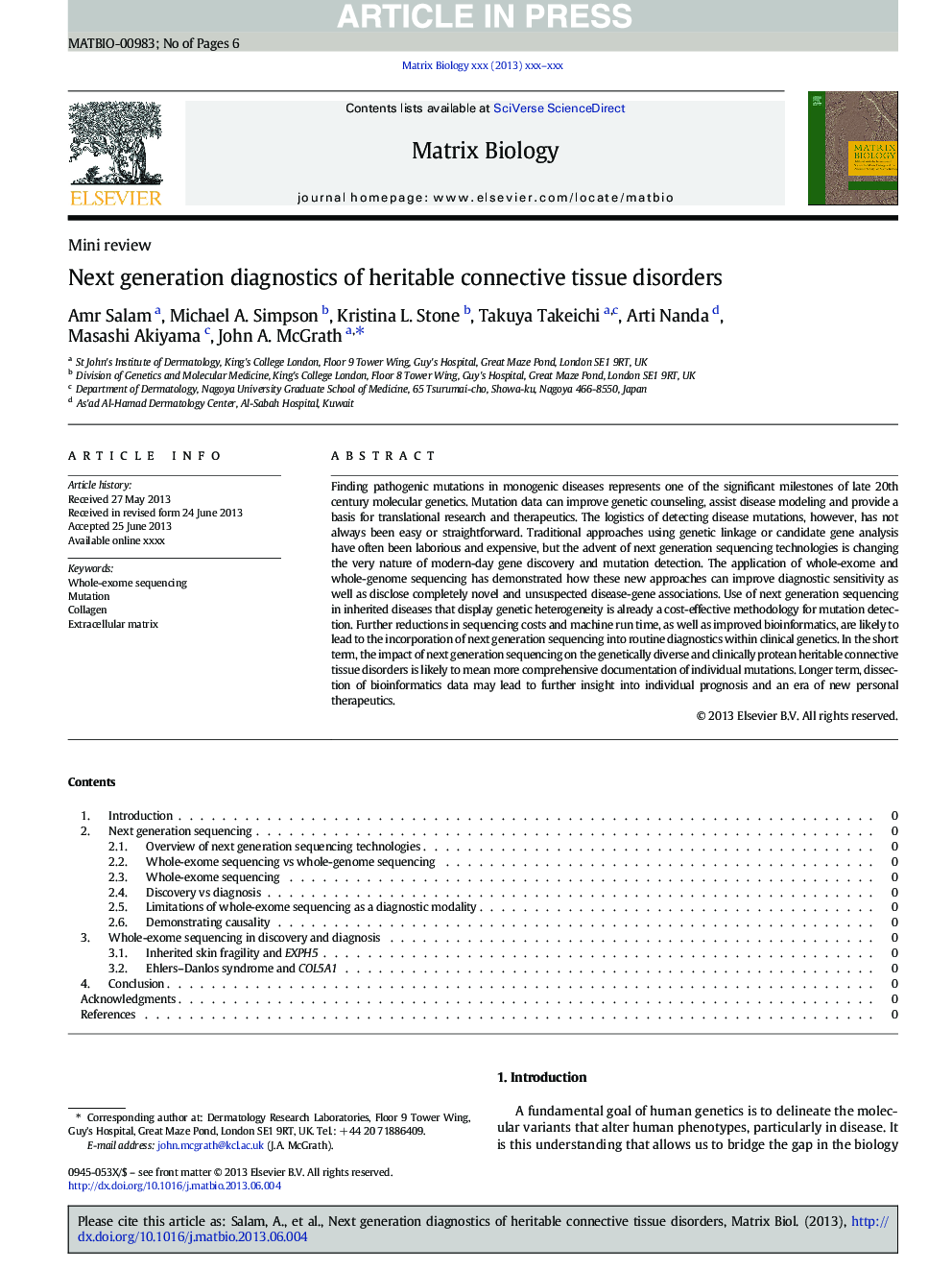| کد مقاله | کد نشریه | سال انتشار | مقاله انگلیسی | نسخه تمام متن |
|---|---|---|---|---|
| 8455496 | 1548023 | 2014 | 6 صفحه PDF | دانلود رایگان |
عنوان انگلیسی مقاله ISI
Next generation diagnostics of heritable connective tissue disorders
ترجمه فارسی عنوان
تشخیص نسل بعدی اختلالات بافت همبند بافتی
دانلود مقاله + سفارش ترجمه
دانلود مقاله ISI انگلیسی
رایگان برای ایرانیان
کلمات کلیدی
توالی انتخابی کامل، جهش، کلاژن، ماتریکس غیر سلولی،
ترجمه چکیده
پیدا کردن جهش های بیماریزا در بیماری های مونوژنیک یکی از نقاط قوت مهم ژنتیک مولکولی قرن بیستم است. داده های موتاسیون می تواند مشاوره ژنتیکی را بهبود بخشد، به مدل سازی بیماری ها کمک کند و مبنای تحقیق و درمان درمانی باشد. با این حال، تدارکات تشخیص جهش های بیماری همیشه آسان و یا ساده نیست. رویکردهای سنتی با استفاده از ژنتیک یا تجزیه و تحلیل ژن کاندیدا اغلب دشوار و گران است، اما ظهور فن آوری توالی نسل بعدی، تغییر ماهیت ژن کشف ژن های جدید و تشخیص جهش را تغییر می دهد. استفاده از توالی کامل و ژنوم کل نشان داد که چگونه این رویکردهای جدید می تواند حساسیت تشخیصی را بهبود بخشد و همچنین کاملا جدید و غیر قابل تشخیص انجمن های ژن بیماری. استفاده از توالی نسل بعدی در بیماریهای ارثی که ناهمگونی ژنتیکی را نشان می دهد، در حال حاضر یک روش هزینه یابی برای تشخیص جهش است. کاهش بیشتر هزینه های توالی و زمان اجرا ماشین، و نیز بهبود زیست فناوری، احتمالا موجب پیوستن توالی نسل بعدی به تشخیص روزمره در ژنتیک بالینی می شود. در کوتاه مدت، تأثیر توالی نسل بعدی بر اختلالات بافتهای همبندی پروتئینی متنوع و بالینی پروتئینی احتمالا به معنای مستند سازی جامعتری از جهشهای فردی است. در دراز مدت، تجزیه اطلاعات بیوانفورماتیک ممکن است منجر به درک بیشتر از پیش آگهی فرد و دوران درمان های جدید شخصی شود.
موضوعات مرتبط
علوم زیستی و بیوفناوری
بیوشیمی، ژنتیک و زیست شناسی مولکولی
تحقیقات سرطان
چکیده انگلیسی
Finding pathogenic mutations in monogenic diseases represents one of the significant milestones of late 20th century molecular genetics. Mutation data can improve genetic counseling, assist disease modeling and provide a basis for translational research and therapeutics. The logistics of detecting disease mutations, however, has not always been easy or straightforward. Traditional approaches using genetic linkage or candidate gene analysis have often been laborious and expensive, but the advent of next generation sequencing technologies is changing the very nature of modern-day gene discovery and mutation detection. The application of whole-exome and whole-genome sequencing has demonstrated how these new approaches can improve diagnostic sensitivity as well as disclose completely novel and unsuspected disease-gene associations. Use of next generation sequencing in inherited diseases that display genetic heterogeneity is already a cost-effective methodology for mutation detection. Further reductions in sequencing costs and machine run time, as well as improved bioinformatics, are likely to lead to the incorporation of next generation sequencing into routine diagnostics within clinical genetics. In the short term, the impact of next generation sequencing on the genetically diverse and clinically protean heritable connective tissue disorders is likely to mean more comprehensive documentation of individual mutations. Longer term, dissection of bioinformatics data may lead to further insight into individual prognosis and an era of new personal therapeutics.
ناشر
Database: Elsevier - ScienceDirect (ساینس دایرکت)
Journal: Matrix Biology - Volume 33, January 2014, Pages 35-40
Journal: Matrix Biology - Volume 33, January 2014, Pages 35-40
نویسندگان
Amr Salam, Michael A. Simpson, Kristina L. Stone, Takuya Takeichi, Arti Nanda, Masashi Akiyama, John A. McGrath,
